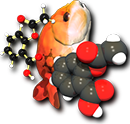PNG 2D depiction (png)¶
or add/extract chemical structures from a .png file
The PNG format has several uses. The most common is to generate a
.png file for one or more molecules.
2D coordinates are generated if not present:
obabel mymol.smi -O image.png
Chemical structure data can be embedded in the .png file
(in a tEXt chunk):
obabel mymol.mol -O image.png -xO molfile
The parameter of the -xO option specifies the format (“file”can be added).
Note that if you intend to embed a 2D or 3D format, you may have to call
--gen2d or --gen3d to generate the required coordinates if they are
not present in the input.
Molecules can also be embedded in an existing PNG file:
obabel existing.png mymol1.smi mymol2.mol -O augmented.png -xO mol
Reading from a PNG file will extract any embedded chemical structure data:
obabel augmented.png -O contents.sdf
Read Options¶
| -y <additional chunk ID> | |
| Look also in chunks with specified ID | |
Write Options¶
| -p <pixels> | image size, default 300 |
| -w <pixels> | image width (or from image size) |
| -h <pixels> | image height (or from image size) |
| -c <num> | number of columns in table |
| -r <num> | number of rows in table |
| -N <num> | max number objects to be output |
| -u | no element-specific atom coloring Use this option to produce a black and white diagram |
| -U | do not use internally-specified color e.g. atom color read from cml or generated by internal code |
| -b <color> | background color, default white e.g |
| -B <color> | bond color, default black e.g |
| -C | do not draw terminal C (and attached H) explicitly The default is to draw all hetero atoms and terminal C explicitly, together with their attched hydrogens. |
| -a | draw all carbon atoms So propane would display as H3C-CH2-CH3 |
| -d | do not display molecule name |
| -m | do not add margins to the image This only applies if there is a single molecule to depict. Implies -xd. |
| -s | use asymmetric double bonds |
| -t | use thicker lines |
| -A | display aliases, if present This applies to structures which have an alternative, usually shorter, representation already present. This might have been input from an A or S superatom entry in an sd or mol file, or can be generated using the –genalias option. For example: obabel -:"c1cc(C=O)ccc1C(=O)O" -O out.png
--genalias -xA
would add a aliases COOH and CHO to represent the carboxyl and aldehyde groups and would display them as such in the svg diagram. The aliases which are recognized are in data/superatom.txt, which can be edited. |
| -O <format ID> | Format of embedded text For example, |
| -y <additional chunk ID> | |
| Write to a chunk with specified ID | |
Comments¶
If Cairo was not found when Open Babel was compiled, then
the 2D depiction will be unavailable. However, it will still be
possible to extract and embed chemical data in .png files.
See also
